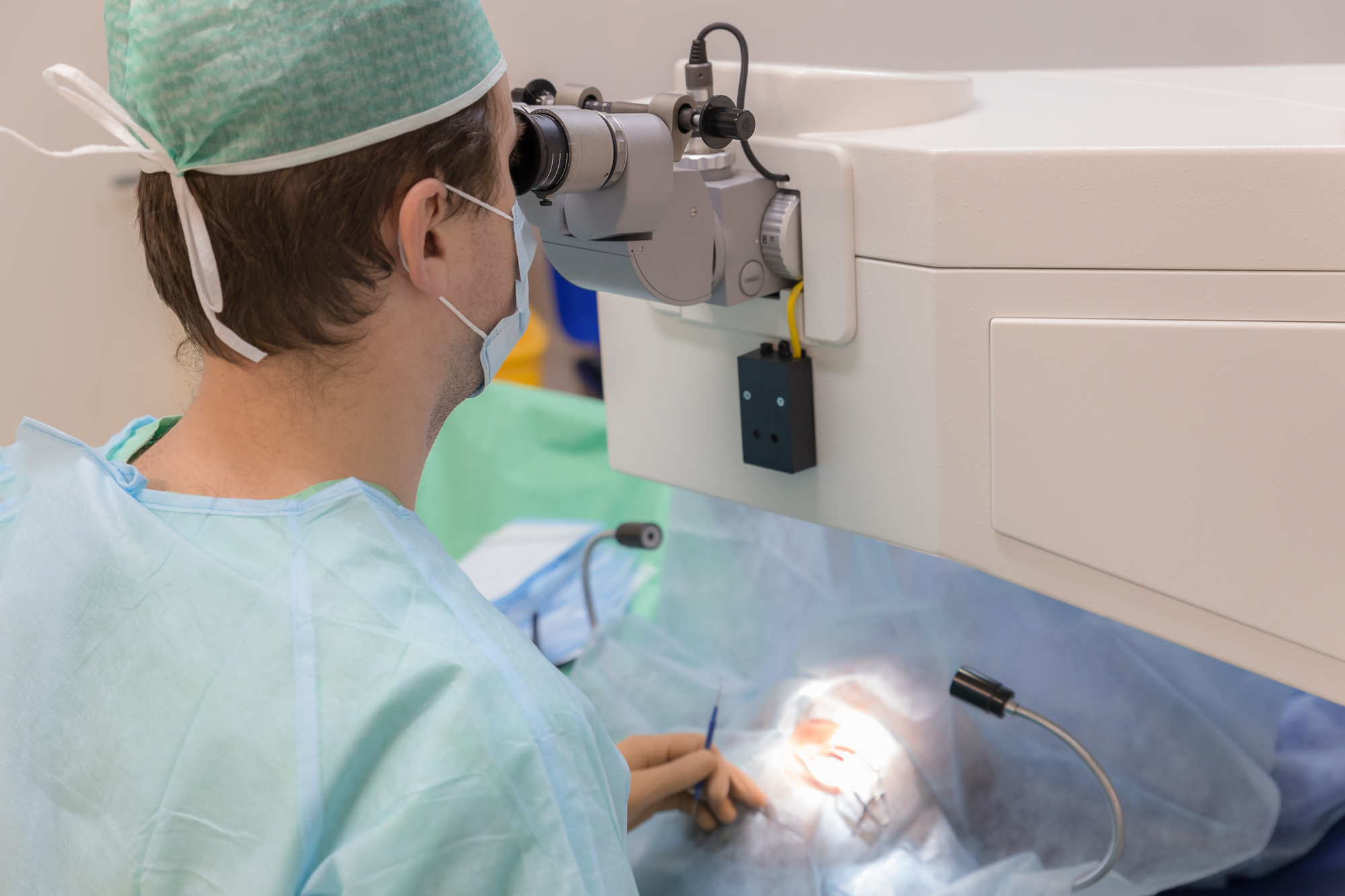Updated on February 20, 2024
Phototherapeutic Keratectomy - Procedure, Aftercare & Costs


Vision Center is funded by our readers. We may earn commissions if you purchase something via one of our links.
What is Phototherapeutic Keratectomy (PTK)?
Phototherapeutic Keratectomy (PTK) is a laser treatment procedure for anterior corneal disorders, including corneal dystrophy, corneal scars, recurrent corneal erosion (RCE), and band-shaped keratopathy. PTK is considered a bridge between surgery and medical management of corneal disorders.

The cornea is the clear front surface of the eye that focuses light on the retina when you look at an object. Any defects in the cornea due to disease or surgery can affect your ability to see.
During PTK, the surgeon uses an excimer laser device to remove any abnormal or diseased tissues on the cornea.
PTK offers a less invasive option and reduces the need for techniques such as lamellar or penetrating keratoplasties, which require partial or complete transplantation of the cornea. It can be used for both therapeutic and refractive purposes.
The PTK procedure has a quick recovery timeline and can be repeated to enhance outcomes.1
Pros and Cons of PTK
Pros of PTK include:
- Effective in treating superficial corneal disorders
- Ideal for people with thin corneas
- No risk of flap-related complications like detachment or displacement because no flap is created
- Less invasive than lamellar or penetrating keratoplasties
Cons of PTK include:
- Risk of infections
- Potential for corneal scarring
- Prolonged recovery time
- Ineffective for deeper scarring
PTK Procedure
PTK is an outpatient procedure, meaning you'll be discharged on the same day. You can expect the following if your eye doctor recommends PTK as your best option:
Preparation
Like any surgery, preparation is important to ensure success. Diagnosis and planning for surgery are based on the doctor's judgment and the slit-lamp examination. A slit lamp is a device that allows the doctor to see the cornea under high magnification.
Other preoperative investigations include:
- Corneal pachymetry. Measures central corneal thickness.
- Corneal topography. Determines the surface integrity of the cornea (irregularities are noted)
- Optical coherence tomography. Determines the depth of the corneal lesion, the expected residual corneal thickness, and the size of corneal ablation required.
Tell your doctor about any medications you're taking. Certain medications such as blood thinners can affect surgery and healing.
The doctor may administer preoperative antibiotic eye drops a day before surgery to reduce the population of normal bacteria in the eyes.3 This prevents the risk of infection during surgery. Avoid eye makeup and other facial lotions days before and on the surgery day, as they might harbor harmful bacteria.4
Your ability to drive may be impaired after surgery. Prepare reliable transportation to and from your doctor's office on the surgery day and the following few days.
Procedure Steps
On the day of surgery, you'll sit on a reclining chair at your doctor's office, and your surgeon will prepare your eyes for surgery.
The procedure is done under topical anesthesia such as Xylocaine (4%) or Proparacaine HCl (0.5%).5 However, local or general anesthesia might be necessary if additional surgery is required.
After applying a speculum to hold your eyelids open, the surgeon will use a computer-guided excimer laser (193 nm), which uses the concept of photoablation (or laser blasting).6 Photoablation is a process where laser energy is directly used to break down target tissue.
During PTK, the excimer laser device sends pulses of laser into the corneal tissues. The laser energy removes the diseased outer corneal layer and smooths the inner surface. One pulse removes approximately 0.25 microns of corneal tissue, making the procedure precise, effective, and low-risk for complications.7
If the corneal surface is rough, the surgeon will apply a masking agent such as hydroxypropyl methylcellulose (HPMC) to smooth it. The masking agent makes the irregular protrusions more visible for ablation.
Once the corneal surface is smoothened, the surgeon will apply bandage contact lenses (BCL) or eye patches to facilitate healing.
Antibiotics and prescription eye drops will also help ease pain and discomfort during recovery. The procedure takes about 10 to 20 minutes for both eyes.
Aftercare & Recovery
After surgery, proper care is necessary to facilitate epithelial healing. You should make your first follow-up appointment at least 24 hours after surgery for your doctor to closely monitor the healing.8 This will prevent complications such as ulceration, scarring, or infection.
You may experience hazy vision and some discomfort for a few days after surgery. However, this is just temporary as the epithelium heals.
The bandage contact lenses (BCL) should be left intact until the epithelium heals. During this time, you'll use prophylactic antibiotic eye drops such as fluoroquinolone. If the eye is patched, you'll use an antibiotic ointment.
Topical nonsteroidal anti-inflammatory drugs (NSAIDs) such as diclofenac sodium may be used to reduce surgical pain. These do not affect the healing process and may reduce the need for oral analgesics.
Once the epithelium heals and the BCL or eye patch is removed, your doctor may prescribe topical corticosteroids such as dexamethasone and fluorometholone to prevent inflammation.
Avoid the following during recovery:
- Rubbing your eyes
- Direct sunlight exposure
- Contact with water
- Facial makeup, lotions, and creams (consult your doctor about when to resume use)
- Contact sports such as football and basketball (may lead to accidental injuries)
- Eye-straining activities such as reading or driving
Your vision may also fluctuate for several months, but most people report satisfactory results after about 3 to 6 months.
Who Should Get PTK?
The best candidates for PTK have opacities (cloudiness) in the front 10 to 20% of the cornea, with no significant irregularity or corneal thinning.
People with corneal scars, corneal dystrophy, RCE, and other superficial corneal disorders can also benefit from PTK.2 In people with both superficial and deep stromal lesions, only superficial lesions are easily treated.
Poor candidates for PTK have systemic diseases such as diabetes mellitus and autoimmune disorders that can affect surgery or healing. Any bacterial or viral infections can also disqualify you from the PTK procedure.
Side Effects and Risks of PTK
The side effects of PTK include:
- Corneal haze (resolves over time)
- Dry eyes
- Tearing
- Vision changes
- Halos and starbursts around lights
- Light sensitivity (photophobia)
The risks of PTK include:
- Excessive corneal thinning
- Reactivation of herpes simplex virus9
- Corneal scarring
- Eye infection
How Much Does PTK Cost?
The cost of PTK will depend on the extent of corneal damage, your surgeon's experience, and the available pre- and post-surgery facilities.
Fortunately, PTK is considered medically significant and therefore covered by most insurance providers. This is especially true when the procedure treats corneal scars, corneal degeneration, dystrophies, or recurrent epithelial erosion.
Talk to your surgeon and insurance provider to determine the cost of your surgery before making a commitment.
Summary
Phototherapeutic keratectomy (PTK) is an outpatient laser treatment procedure for anterior corneal disorders. PTK is considered a bridge between surgery and medical management of these disorders. It provides both therapeutic and refractive benefits.
The best candidates for PTK have opacities, corneal scars, corneal dystrophy, recurrent corneal erosion (RCE), and other superficial corneal disorders. The procedure involves removing the diseased epithelium and smoothening the corneal tissues with an excimer laser.
PTK is considered medically necessary and covered by insurance if it's recommended for therapeutic reasons. Your surgeon will conduct a comprehensive eye exam to determine if PTK will work for you.
In this article
9 sources cited
Updated on February 20, 2024
Updated on February 20, 2024
About Our Contributors
Vincent Ayaga is a medical researcher and seasoned content writer with a bachelor's degree in Medical Microbiology. Specializing in disease investigation, prevention, and control, Vincent is dedicated to raising awareness about visual problems and the latest evidence-based solutions in ophthalmology. He strongly believes in the transformative power of ophthalmic education through research to inform and educate those seeking knowledge in eye health.
Dr. Melody Huang is an optometrist and freelance health writer with a passion for educating people about eye health. With her unique blend of clinical expertise and writing skills, Dr. Huang seeks to guide individuals towards healthier and happier lives. Her interests extend to Eastern medicine and integrative healthcare approaches. Outside of work, she enjoys exploring new skincare products, experimenting with food recipes, and spending time with her adopted cats.

